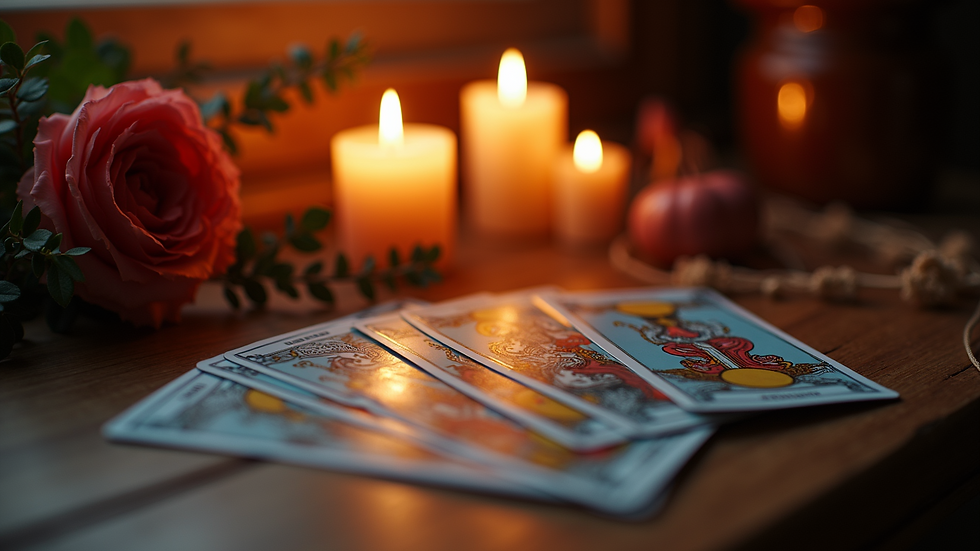Understanding the Symbolism in Tarot Readings
- Divine Tarot
- Mar 26
- 4 min read
Tarot readings offer a unique way to tap into your intuition and reflect on your life's journey. At its core, the Tarot deck consists of 78 cards, each rich with its own symbolism. Understanding the meaning behind these symbols can deepen your readings and allow you to interpret the cards beyond their surface meanings.
Tarot Readings: A Deep Dive into Symbolism
Before delving into the specific symbols in tarot readings, it's essential to understand how these readings work. A tarot reading involves drawing cards from a shuffled deck. Each card's position in the spread influences its interpretation, which is often linked to personal experience, spiritual insights, or question-specific guidance.
Each card is part of one of two main sections in the tarot deck: the Major Arcana and the Minor Arcana. The Major Arcana cards represent significant life events, spiritual lessons, or karmic influences, while the Minor Arcana focuses on everyday events and experiences.
The Major Arcana: Key Symbols and Their Meanings
The Major Arcana contains 22 cards, each representing profound life lessons and archetypical energies. Here are a few notable cards and their symbolic meanings:
The Fool: This card symbolizes new beginnings, adventure, and spontaneity. It represents the courage to take risks and embrace the unknown. Imagine standing on the edge of a cliff, ready to leap into new possibilities.
The High Priestess: Known for her connection to intuition and the subconscious, this card encourages you to trust your inner voice. She often appears when you need to explore your inner landscape or when secrets are at play.
Death: Don’t be alarmed; this card symbolizes transformation and change. It's a clear indication that a chapter in your life is ending, paving the way for new beginnings.
The Empress: Representing fertility, abundance, and nurturing, the Empress is a reminder to embrace creativity and the beauty of life. She signifies growth and the importance of self-care.

These cards encapsulate deep psychological and spiritual themes that can resonate with your current life situation.
The Minor Arcana: Everyday Symbols
The Minor Arcana cards are split into four suits: Cups, Wands, Swords, and Pentacles. Each suit corresponds to different aspects of life.
Cups: Associated with emotions and relationships, the Cups reveal insights into your feelings and connections with others. For example, the Two of Cups represents partnership and mutual attraction.
Wands: This suit symbolizes inspiration, action, and leadership. The Ace of Wands signifies new opportunities and igniting your passions.
Swords: This suit deals with thoughts, communication, and conflict. The Three of Swords often symbolizes heartbreak or emotional pain but can also signify necessary growth through hardship.
Pentacles: These cards focus on material aspects, career, and finance. The Eight of Pentacles signifies hard work, dedication, and the pursuit of mastery in your craft.

Colors and Symbols: Deciphering Their Meanings
In addition to the cards themselves, colors and symbols hold significant meaning in tarot readings. Each color can evoke specific emotions:
Red: Often linked to passion, vitality, and power. It can suggest intensity in a situation or relationship.
Blue: Represents calm, trust, and communication. It encourages clarity in expressing emotions.
Green: Connected to growth, health, and renewal. Green often appears when you're on the path to healing or abundance.
Symbols in tarot are also crucial. For example:
The Moon: Often symbolizes intuition, dreams, and the subconscious. It can represent confusion or uncertainty but also the potential for deep insights.
The Sun: Represents enlightenment, success, and vitality. It indicates positivity and joy.
Understanding these color and symbol associations can enhance the context of your readings, allowing for a more thorough interpretation.
The Context of Your Question
When you conduct a tarot reading, the context of your question dramatically shapes the symbols' interpretations. A love question will yield different insights than a question about finances, even with similar cards drawn.
For instance, drawing the Ace of Cups in a love reading signifies the beginning of a new relationship or emotional awakening. However, if drawn in a financial reading, it may suggest generosity or new opportunities in monetary matters. It's essential to adapt the meanings of the symbols to the context you're exploring.

Practical Tips for Interpreting Symbolism
If you're new to tarot or seeking to deepen your practice, here are some actionable tips:
Keep a Tarot Journal: Write down your card draws, their meanings, and your interpretations. This practice helps reinforce memory and personal associations with each card.
Meditate on the Cards: Spend time reflecting on individual cards. Ask questions about what personal experiences or emotions they evoke.
Use Spreads: Familiarize yourself with common tarot spreads like the three-card spread or the Celtic Cross. These spreads can provide more structured insights and guide the reading's flow.
Intuitive Insight: While learning traditional meanings is crucial, trust your gut feelings. Allow your intuition to guide interpretations, creating a more personal reading experience.
Swap Readings with Friends: Practicing with others can offer fresh perspectives and foster discussions about symbol meanings. You may uncover insights that you had not considered.
Engaging with Tarot Readings
As you explore tarot readings, remember that each session is a personal journey. The symbols act as a bridge to understanding your situation. The cards are tools for reflection, not definitive answers. Embrace the exploration to unlock clarity and personal revelation.
One fantastic resource to explore is also divine tarot, where you can find more insights, card meanings, and tarot-related practices.
Final Thoughts on Symbolism in Tarot Readings
The symbolism in tarot readings opens doors to profound self-discovery and insight. By understanding the meanings behind each card, colors, and symbols, you can enhance your reading experience. Tarot is not just about divination; it’s a pathway to understanding yourself and the world around you.
Whether you're a beginner or an experienced reader, embracing these symbols can empower you to navigate life's complexities more astutely. Continue your journey of exploration and interpretation, allowing the tarot to illuminate your path.
.png)
Kommentarer